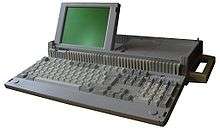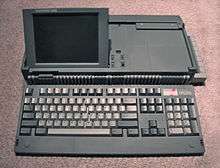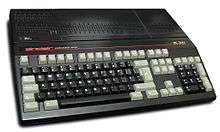PPC 512
The Amstrad PPC512 and Amstrad PPC640 were the first portable IBM PC compatible computers made by Amstrad. Released in 1988, they were a development of the desktop PC-1512 and PC-1640 models. As portable computers, they contained all the elements necessary to perform computing on the move. They had a keyboard and a monochrome LCD display built in and also had space for disposable batteries to power the PC where a suitable alternative power source (i.e. mains or 12 volt vehicle power) was not available. The PCs came with either one or two double density double side floppy disc drives and the PPC640 model also featured a modem. Both models were supplied with 'PPC Organiser' software and the PPC640 was additionally supplied with the 'Mirror II' communications software.
Hardware


The two computers had very similar specifications. The PPC512 had an NEC V30 processor running at 8 MHz, 512 KiB of memory, a full-size 102-key keyboard, a built-in liquid crystal display (not backlit)[1] that could emulate the CGA or MDA and either one or two 720k 3.5" floppy drives (the model was either the PPC512S or PPC512D depending on the number of drives it had). The PPC640 was otherwise identical except that it had 640 KiB of memory, a built-in modem, and its case was a darker shade of grey. Both versions of the machine had an empty socket on the main circuit board so that an Intel 8087 coprocessor could be installed to permit hardware processing of floating point arithmetic.
The PPC included standard connectors for RS-232, Centronics and CGA/MDA video, allowing existing peripherals to be used. All the signals used by the 8-bit ISA bus were also available through an expansion connector.
Four possible power sources could be used:[2]
- Ten C-size alkaline batteries. (10 x 1.5v = 15 volts, but the load was such the voltage dropped to nearer 12 volts in use.)
- Mains adaptor
- Car cigarette lighter.
- An Amstrad PC-MD, PC-CD or PC-ECD Monitor. (These monitors all contained a power supply)
The physical layout of the components was unlike most laptop designs: instead of the lid containing the screen, it contained the keyboard. The hinges were therefore at the front of the main unit, rather than the back. The LCD was hinged separately and folded down into a recess on the top of the system unit. The one or two floppy drives were located on the right-hand side. When closed, the size of the PPC was 45 cm wide × 10 cm high × 23 cm deep.
A bank of six DIP switches was used to select whether the video hardware emulated CGA or MDA, and whether to use an internal or external monitor.
No official hard drive option or docking station was manufactured, but both were sold by third-party manufacturers.
Software
MS-DOS 3.3 was supplied with all PPCs, along with 'Organizer' - a memory-resident suite of utilities including a card file, diary, calculator and telephone dialler. In addition, the PPC 640 was supplied with Mirror II, a communications package for use with the built-in modem.
The MS-DOS boot disk also included a utility which could be used to switch between the internal display and an external monitor without rebooting.
Amstrad PC20 / Sinclair PC200

In late 1988 Amstrad created a desktop computer based on the PPC design, intended for the home market. The LCD was replaced by an RF modulator to display CGA video on a domestic television, and the keyboard and system unit were combined in an integrated case similar to the original Atari ST or the Amiga 500. The second floppy drive bay was replaced by two ISA slots, though the design of the case was such that any cards fitted would protrude from the top of the computer. The PC200 had a black case and 'Sinclair' branding, while the PC20 was white and branded 'Amstrad'; the two were otherwise identical.
In addition to MS-DOS 3.3 and Organizer, the PC20/PC200 was supplied with GEM and four CGA-compatible games.
The graphical capabilities (CGA) and sound output (PC speaker) were greatly inferior compared to other home computers of the time. Consequently, the PC20/PC200 was not a commercial success.
Although the PC20/PC200 does not support today's floppy disk drives through the built-in FDD connector, it uses a compatible floppy disk controller (Zilog Z765a) that can work after modification of the FDD connector, though only with 720k disks.
References
- "The PPC: A carry out for the future?" Amstrad Professional Computing, March 1988.
- www.retro-zone.org Amstrad PPC (archived)
- Sinclair PC200 Service Manual